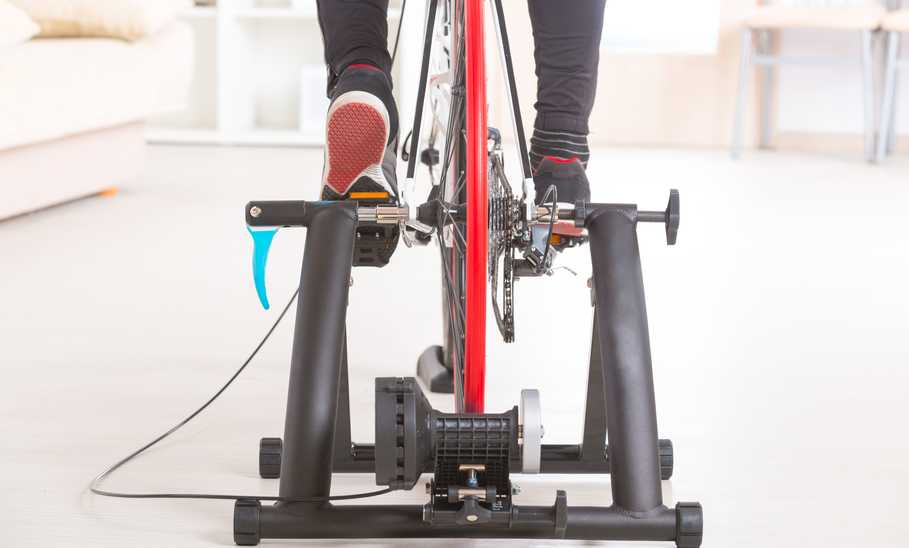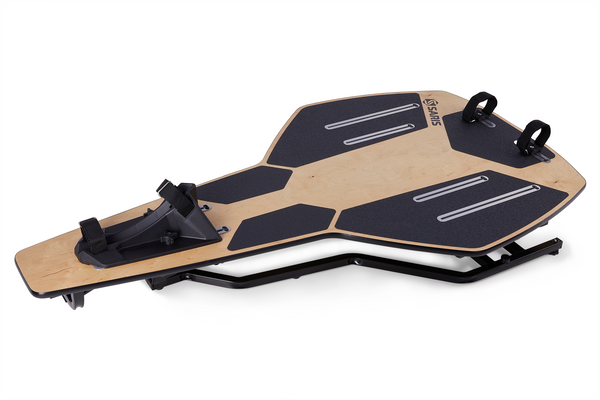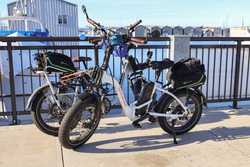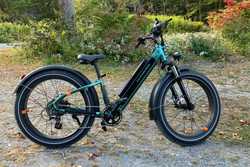While it’s always preferable to perform your training rides outside, your location, in addition to factors like weather and daylight, don’t always allow for that. Indoor bike trainers can be a fantastic solution, allowing you to still get in a workout. Bike trainers come with a wide variety of designs, features, and price points, so I talked with biking experts to find out just what to look for when buying an indoor trainer. I’ve highlighted some of the best indoor bike trainers that you’ll want to check out, as well as some tips to help you shop.
Our top picks for the best indoor bike trainers

Deuter Bike Trainer
13% offSave $15
The Deuter Bike Trainer features a basic but effective design. It features a 330-pound capacity and works with most bikes, including mountain bikes and street bikes. The magnetic resistor provides six resistance levels, and the trainer is available in four colors. While this trainer doesn’t have some of the output monitoring or data collection tools that other indoor trainers offer, its affordable price makes it appealing, especially if you’re looking to try out an indoor trainer for the first time.
Specifications
- Dimensions: 24.41 inches x 21.65 inches x 7.87 inches
- Type: Wheel-on
- Tire diameter: 26-29 inches
- Material: Alloy steel
- Load capacity: 330 pounds
- Weight: 22.27 pounds
- Price on publish: $84.97
Pros:
- Drive-by-wire allows you to change the resistance directly from your handlebars
- Magnetic resistor allows you to choose from six resistance levels
- Folds up, and is easy to set up and pack away
- Fits most bikes, including city bikes and mountain bikes, with tires from 26 to 29 inches
- Quick clamp makes it easy and fast to attach or remove your bike
Cons:
- To minimize noise, it’s recommended to change out router tread tires with smoother tires
- No output monitoring or other data collection tools
The bottom line:
This indoor trainer is a highly affordable option, yet it still offers six resistance levels and can work with most bikes, including both street bikes and mountain bikes.
The MP1 platform facilitates forward, backward, and side-to-side movement to create a training experience that resembles outdoor riding. That movement also helps to keep bicyclists more comfortable. This rocker platform is designed to be compatible with all major bike trainer brands and models, and it arrives fully assembled.
Specifications
- Dimensions: 6 inches x 63 inches x 35.5 inches
- Type: Rocker platform
- Tire diameter: Compatible with all major bike trainer brands and models
- Material: Steel, aluminum, birch
- Load capacity: 350 pounds
- Weight: 62 pounds
- Price on publish: $849.99
Pros:
- Arrives fully assembled
- Backed by a limited lifetime warranty
- Allows for a side-to-side angle of up to six degrees
- Grip tape helps to make it easier to walk on the platform
- Forward, backward, and side-to-side movement enhances comfort and replicates outdoor riding
Cons:
- Expensive
- Relatively heavy
The bottom line:
The MP1 platform helps to create side-to-side, forward, and backward movement during every ride, making for an extra realistic feel and creating a more comfortable workout experience.

Saris Fluid2 Indoor Bike Trainer
This indoor bike trainer’s fluid resistance makes for a smooth ride, and a cooling system helps to keep the unit cool during operation. It includes a steel quick release skewer for road and mountain bike frames, and a thru axle adapter is sold separately. This trainer is compatible with Zwift and other apps, and since it includes a one-month subscription to the Rouvy virtual training app, you can track your training progress.
Specifications
- Dimensions: 22 inches x 19.5 inches x 7 inches
- Type: Wheel-on
- Tire diameter: 27.5 inches, 29 inches
- Material: Composite, aluminum, plastic
- Load capacity: 300 pounds
- Weight: 7.3 pounds
- Price on publish: $249.99
Pros:
- Cooling system moves air through the trainer to help keep it cool during use
- Fluid resistance unit for a smooth ride
- Compatible with training apps and includes a one-month subscription to the Rouvy virtual training app
- Foldable frame includes a leveling block
- Features a limited lifetime warranty
Cons:
- Bikes with a thru axle will need an adapter
- Requires some assembly
- Not compatible with 26-inch tires, or 29-inch tires wider than 1.5 inches
The bottom line:
This indoor trainer’s fluid resistance makes for a smooth ride, and it includes a one-month subscription to the Rouvy virtual training app to help enhance your training.

Elite Direto XR-T Home Bike Trainer
32% offSave $221
This smart trainer includes many features for enhanced and easy use, yet it’s still reasonably priced. Its integrated power meter can help you monitor your training, and since the trainer offers ANT+ and Bluetooth connectivity, you can connect it to other devices like heart rate monitors and cadence sensors to gather even more data on your workout. It’s compatible with most road and mountain bikes out of the box for an easy setup.
Specifications
- Dimensions: 20 inches x 20 inches x 30 inches x
- Type: Direct drive
- Tire diameter: Compatible with 9-, 10-, 11-, and 12-speed road and mountain cassettes, tire diameter not specified
- Material: Carbon steel
- Load capacity: Not specified
- Weight: 40 pounds
- Price on publish: $494.26
Pros:
- Integrated power meter and capable of connecting with heart rate monitors and cadence sensors
- Automatically adjusts resistance while you work out
- Capable of replicating up to 24% gradients for realistic training
- Features ANT+ and Bluetooth connectivity, so it’s easy to connect to your device
- Backed by a 2-year manufacturer guarantee
Cons:
- Mountain bike hubs require an adaptor, sold separately
- Load capacity not specified
The bottom line:
This smart trainer not only features an integrated power meter, but can also connect with other devices like heart rate monitors and cadence sensors, so it’s easy to use and provides detailed data about your training.

Feedback Sports Omnium Over-Drive Portable Bike Trainer with Travel Bag
This portable trainer folds down to just 26 x 8 x 8 inches and weighs only 14 pounds, ideal for transporting. Since it’s made of weather-resistant materials, this trainer is suitable for indoor use, or for warmups and cooldowns outdoors at events. Plus, since the bearings are greased and sealed, there’s no maintenance to worry about, so you can focus on your training.
Specifications
- Dimensions: 60 inches x 33 inches x 20 inches
- Type: Direct drive
- Tire diameter: Any
- Material: Aluminum, alloy steel
- Load capacity: 225 pounds
- Weight: 14 pounds
- Price on publish: $490
Pros:
- Folds up and features a travel tote for easy storage and transportation
- Adjustable design can fit any bike
- Speed-responsive resistance helps to create a realistic feel
- Weather-resistant and suitable for indoor or outdoor use at events
- Weighs just 14 pounds
Cons:
- Only 1 setting
- Lightweight design isn’t as stable as some more robust trainers
The bottom line:
This indoor trainer weighs just 14 pounds, includes a carry bag, and is suitable for indoor or outdoor use, so it’s an ideal choice if you’re looking for a trainer that you can take on the road to events with you.
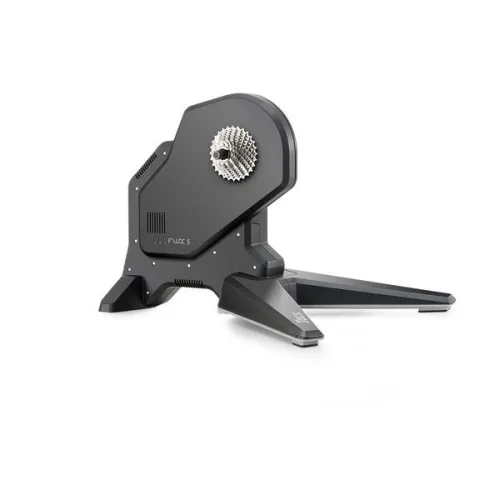
Tacx FLUX S Smart Trainer
This smart trainer is designed to simulate the feel of road riding. It’s capable of simulating inclines up to a 10% gradient, and the heavy flywheel adds a realistic, responsive feel to each ride. While the trainer helps to simulate the experience of riding on the road, it’s quiet and helps to minimize vibration, making for a comfortable ride.
Specifications
- Dimensions: 26.4 inches long x 25.3 inches wide x 18.1 inches high
- Type: Direct drive
- Tire diameter: Suitable for quick release axles (130 mm/135mm x 5mm), no tire specifications
- Material: Not specified
- Load capacity: Not specified
- Weight: 50.3 pounds
- Price on publish: $749.99
Pros:
- Features ANT+ and Bluetooth connectivity for easy pairing with your devices
- Measures your speed, cadence, and power with 3% accuracy
- Simulated inclines help to add realism to your rides
- Quick-release feature designed for convenient use with your road and mountain bike
- Includes a 1-month Tacx Premium software and 1-month Zwift membership software trial
Cons:
- Load capacity isn’t specified
The bottom line:
This smart trainer features a heavy flywheel for a realistic, responsive feel, while its ability to simulate up to 10% gradient inclines helps to reproduce the feel of riding on the road.

Wahoo Kickr Core Direct Drive Bike Resistance Trainer
This direct drive trainer can be paired with a device, like a smartphone or tablet, and will automatically control the resistance for a highly realistic training session. The 12-pound flywheel creates a precise feel, and the trainer records your power, speed, distance, and cadence metrics. This is a solid, durable machine, thanks to its carbon steel construction, and it’s backed by a one-year warranty.
Specifications
- Dimensions: 23.62 inches x 15.75 inches x 15.75 inches
- Type: Direct drive
- Tire diameter: 24-, 26-, 27.5-, and 29-inch
- Material: Carbon steel
- Load capacity: 250 pounds
- Weight: 50 pounds
- Price on publish: $496.68
Pros:
- Can be paired with your smartphone, tablet, computer, or GPS bike computer
- When connected to a device, the trainer automatically sets your resistance for a realistic riding experience
- Rugged steel construction for stability and durability
- Precision flywheel technology for accurate yet quiet training
- 8-, 9-, 10-, 11-, and 12-speed options allow you to customize the trainer to your preferences
Cons:
- Several buyers have experienced technical issues with the Wahoo app
- No wheel block included
The bottom line:
From its durable carbon steel construction to the fact that the trainer automatically sets your resistance and monitors metrics like power, speed, distance, and cadence, it’s an easy to use and quality direct drive trainer.

Sportneer Bike Trainer
The Sportneer Bike Trainer features eight magnetic resistance settings to put you in control of your ride intensity. A wide base is paired with adjustable rubber feet for stability, even when on uneven flooring. The trainer includes a front wheel riser block and quick release lever, and it fits most mountain and road bikes.
Specifications
- Dimensions: 24.6 inches long x 23 inches wide x 8.6 inches high
- Type: Friction trainer
- Tire diameter: 26-28 inches
- Material: Stainless steel
- Load capacity: Not specified
- Weight: 22.6 pounds
- Price on publish: $79.99
Pros:
- Adjustable anti-slip rubber feet for use on uneven floors
- 8 resistance settings to simulate different training conditions
- Down lever clamp easily releases your bike
- Backed by a 1-year warranty
- Includes a front wheel block
Cons:
- No smart tracking or metrics features
- Load capacity isn’t provided
The bottom line:
The affordably priced Sportneer Bike Trainer features eight resistance settings, has adjustable feet for stability on uneven surfaces, and fits most mountain and road bikes.

Suito Pack Direct Drive Home Bike Trainer
33% offSave $200
While this home bike trainer is easy to store away, it offers a highly stable feel while in use. It features legs that unfold to create four points of contact, suitable for even intense workouts. Folded up, it measures 22 inches long x 19 inches wide x 5 inches high, so it’s easy to store or transport. It can also simulate grades of up to 15% to add intensity to your workout.
Specifications
- Dimensions: 27 inches x 23.5 inches x 10.5 inches
- Type: Direct drive
- Tire diameter: Compatible with most road and mountain bikes
- Material: Alloy steel
- Load capacity: Not specified
- Weight: 40 pounds
- Price on publish: $438.99
Pros:
- Folds up to measure 22 inches long x 19 inches wide x 5 inches high
- Can simulate up to a 15% grade for a realistic feel
- 4 points of contact add stability
- ANT+ and Bluetooth connectivity, so you can pair the trainer with apps and devices
- Backed by a 2-year manufacturer warranty
Cons:
- No specified load capacity
- A more expensive option
The bottom line:
This indoor trainer folds up for compact storage, but with the legs unfolded its steel construction makes for a stable feel suitable for even intense workouts.
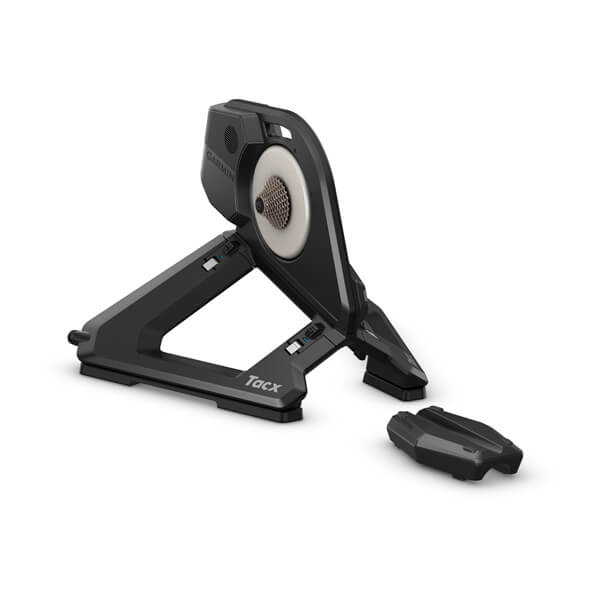
Tacx NEO 3M Smart Trainer
The Tacx NEO 3M Smart Trainer is designed to provide a highly realistic feel. It can simulate inclines up to a 25% gradient, and also simulates different road types, like gravel or cobblestone, allowing you to practice riding over different surfaces. The trainer also creates multidirectional movement, which allows for a more natural and more comfortable riding position. This highly stable trainer can support explosive sprints, and also offers highly accurate metrics tracking. It’s backed by a limited one-year manufacturer warranty.
Specifications
- Dimensions: 31.5 inches x 24.8 inches x 23.4 inches
- Type: Direct drive
- Tire diameter: Supports quick release axles and thru-axles, adapters are available for bikes without standard dimensions
- Material: Not specified
- Load capacity: Not specified
- Weight: 52 pounds
- Price on publish: $1,999.99
Pros:
- ANT+ and Bluetooth connectivity to integrate with apps like the Tacx Training App and Zwift
- Measures cadence, speed, and power within 1% accuracy
- Simulates inclines up to a 25% gradient for realistic training
- Flywheel simulates different road types, like cobblestone and gravel, for versatile training
- Built-in motion plates create multidirectional movement for a realistic feel and a more natural riding position
Cons:
- Very expensive
- Load capacity isn’t identified
The bottom line:
This trainer provides a highly realistic outdoor riding experience, including multidirectional movement, the simulation of different surface types, and the ability to replicate up to a 25% gradient for hills training.
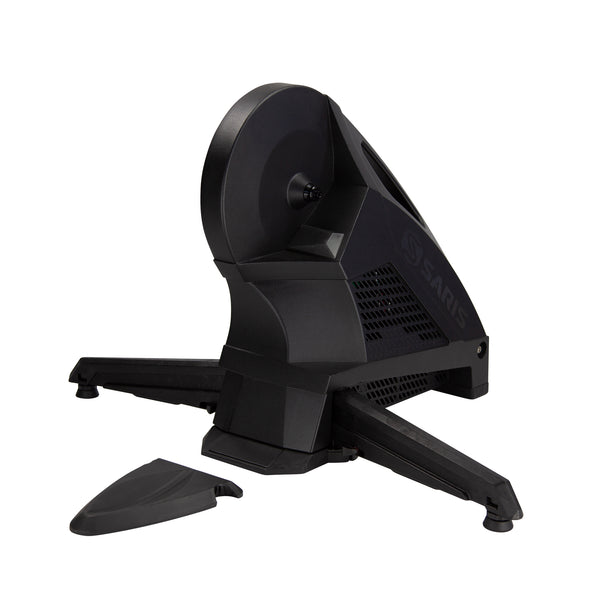
Saris H3 Direct Drive Smart Indoor Bike Trainer
Designed for mountain bikes, this trainer features a quiet operation and an electromagnetic resistance for a consistent workout. It’s capable of replicating up to a 20% climbing grade, and it measures speed, cadence, and power without requiring any external sensors. Its ANT+ and Bluetooth connectivity mean you can pair it with cycling apps and devices, and the trainer includes a one-month subscription to the Rouvy training app.
Specifications
- Dimensions: 22 inches long x 22 inches wide x 12 inches high
- Type: Direct drive
- Tire diameter: 29 inches
- Material: Composite, aluminum, plastic
- Load capacity: 300 pounds
- Weight: 59 pounds
- Price on publish: $649.99
Pros:
- ANT+ and Bluetooth connectivity to pair with indoor cycling apps
- Measures speed, cadence, and power within 2% accuracy
- Folding legs for stability yet easy transportation and storage
- Cooling system moves air through the trainer to help keep it cool during use
- Backed by a limited lifetime warranty
Cons:
- Expensive
- Not suitable for road bikes
The bottom line:
This trainer is designed for mountain bikes, features electromagnetic resistance, and can replicate up to a 20% climbing grade for consistent workouts when you can’t get outside on the trails.

Tacx Neo Bike Smart Trainer
The Tacx Neo Bike Smart Trainer is full of features to enhance your training and performance. The bike can replicate up to a 25% gradient, simulates the feel of riding on different surfaces like gravel, and the gear feel replicates the feel of your chain changing into a different gear for a highly realistic experience. The trainer is capable of analyzing your pedal stroke to help you become more efficient, and data measurements of your power, speed, and cadence give you valuable information about every training session.
Specifications
- Dimensions: 47.24 inches x 31.1 inches x 11.42 inches
- Type: Dedicated setup
- Tire diameter:
- Material: Stainless steel
- Load capacity:
- Weight: 110 pounds
- Price on publish: $2,949.13
Pros:
- Measures speed, cadence, and power within 1% accuracy
- Analyzes your pedaling technique to help make you more effective
- Replicates up to a 25% gradient
- Adjustable pedal, saddle, handlebar, bar tape, and crank lengths for a customized feel
- Includes a 2-year limited warranty
Cons:
- Expensive
- Requires a lot of space
The bottom line:
Not only does this trainer replicate the feel of riding on different surfaces and different gradients, it’s capable of analyzing your pedal stroke to help you develop a more effective technique.
How we selected the best indoor bike trainers
I carefully considered the experts’ advice when choosing the best indoor bike trainers. I looked for trainers that worked with a variety of bike types and sizes, and focused on trainers that are constructed from quality materials. Here’s what else I considered:
Versatility
I looked for indoor bike trainers that could fit most bike types and bike tires, and a load capacity that could handle different types of riders. I also looked for a range of trainers with different footprints to support a range of riders.
Workout quality
I also looked for features to enhance your training sessions, such as the ability to replicate hills and even to create motion while you’re on your bike. Offers features that enhance your workout, like resistance and motion simulator or incline simulator functions. Metrics/data collection and compatibility with fitness trackers were also a plus—and accuracy was crucial.
Ease of set-up
I looked for quick release features and pre-assembled components to make set-up a breeze. I also made sure to look at the overall product weight, as indoor bike trainers can get heavy; and whether it could be stored or transported.
Finally, I tried to include bike trainers that would work for various budgets.
What to consider when buying indoor bike trainers
Size
Katie Pierson, a certified personal trainer and certified spin instructor, teaches at the Ridge Athletic Club in Bozeman, Montana, and writes for Girl Bike Love. It’s important to consider the trainer’s size, as well as the amount of space that your full setup will require, she says
Dr. Jordan Duncan is the owner of sports medicine and fitness clinic Silverdale Sport & Spine in Silverdale, Washington. He notes that beginner riders should start with a trainer with a wide footprint for more stability. “This decreases the risk of tipping over when riding on an indoor trainer,” he says.
Compatibility with your bike
Duncan says to make sure your bike fits in the trainer. “You will need to know what type of bike you have, the wheel size, and whether it has a thru-axle, or a quick-release skewer,” he explains. “Most bike trainers are compatible with a variety of bike styles and tire sizes, but it’s essential to check.”
Noise levels
It’s also important to consider the noise levels the trainer generates. Those noise levels can impact your ability to work out at home while other family members are nearby, as well as your ability to easily hear music or watch training programs while using the equipment. “Quieter, more immersive riding options tend to be more expensive,” says Pierson.
Power accuracy
Pierson notes power accuracy is also important. “I prefer trainers that offer better power accuracy, as they better indicate how my training is going, and my progress,” she says.
According to Wahoo Fitness, smart trainers can measure power in different ways. Pedal-based meters are often some of the most accurate. Calibrating the power meter is important for accuracy, so be sure to refer to the trainer’s calibration instructions.
“Smart trainers provide real-time heart rate, speed, cadence, and power input information,” says Duncan. “These features allow you to monitor your performance, track improvements, and adjust your training.”
Price
Indoor bike trainer prices can vary significantly. “The more you spend, the quieter and more realistic your trainer setup will be,” explains Duncan. That said, it’s important to consider your budget when deciding what you want to spend on a bike trainer.
What is a smart trainer?
“A smart bike trainer is a piece of equipment that conveniently transforms your regular bike into a stationary bike” explains Pierson. “A smart bike trainer helps transmit essential metrics such as watts via Bluetooth or ANT+ to various apps and changes the resistance.”
Duncan explains that smart trainers offer the ability to automatically increase and decrease resistance to simulate changes in gradient. That capability provides a more challenging and more realistic workout. “Smart trainers can also pair with your heart rate monitor, which is ideal for targeting specific power or heart rate training zones,” he says.
How to maintain and clean indoor bike trainers
Piersen explains that it’s important to always disconnect your smart trainer from the power source before cleaning it. Then, you can wipe it with a damp microfiber towel that won’t leave behind any lint. Be sure to let the trainer fully dry before you use it.
Types of indoor trainers
According to Piersen, indoor trainers fall into two main categories: Direct drive trainers and wheel-on trainers.
“Direct drive trainers provide the most realistic riding experience,” she says. “This type of trainer offers a lot of stability because the model requires that the back wheel be removed and the bike be connected to the cassette and axle.”
There are two main types of wheel–on trainers. Roller wheel-on trainers are some of the most affordable, since the bike doesn’t need to be modified. However, Piersen notes that this type of trainer requires the rider to have more balance than other trainers, since the bike only rests on the rollers and isn’t otherwise secured to the trainer.
Friction wheel-on trainers are more affordable and portable than direct drive trainers. However, the smaller roller that rests against the back wheel creates more noise.
Smart features and training apps
Indoor bike trainers are available with many smart features, including the ability to monitor heart rate, speed, cadence, and power output. You can often access this information via an app, giving you valuable information on your training progress and helping you to plan future training sessions.
Where to set up your trainer
Duncan recommends that you ensure that you have plenty of space available for your indoor bike trainer setup. “Indoor bike trainers require a decent amount of room,” he says. “You’ll want the room you’re riding in to have excellent airflow and ventilation, which can include open doors, windows, air conditioning, and portable fans.”
Frequently asked questions (FAQs)
Are indoor bike trainers any good?
Indoor bike trainers can be valuable training tools for cyclists, athletes, and anyone looking to maximize the amount of time that they’re able to spend on their bike. Since indoor bike trainers can work with your existing bicycle, they’re a great solution when you’re unable to ride outdoors because of weather or other conditions. Bike trainers can give you a highly realistic feel, making for a smooth transition when you’re able to get back on the road again.
What is the best trainer for cycling?
There’s no single best trainer for cycling, and each of the trainers on our list offers great value and performance. It’s important to choose a trainer that’s best for your needs, so consider your budget, how you plan to use the trainer, your experience level, and the features that are most important to you.
What is the quietest indoor bike trainer stand?
Direct drive trainers tend to be some of the quietest, because the bike’s back wheel is removed and the bike is secured to the trainer. This design helps reduce some of the vibration that you tend to experience with an on-wheel trainer.
My indoor trainer is making a lot of noise. Is this normal?
There will be some noise when you use an indoor trainer, especially if you’re riding in an acoustically live space, like a basement without carpeting or rugs. If your trainer suddenly becomes louder or starts to make a new noise, then check the owner’s manual for any troubleshooting advice and consider contacting the manufacturer if you can’t identify the problem.
